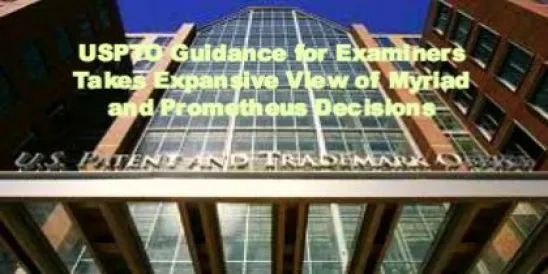On March 4, 2014, the U.S. Patent and Trademark Office (“USPTO”) issued a memorandum to the Patent Examining Corps with guidance for determining the patent eligibility of claims relating to products of nature and laws of nature (“the Guidance”) in view of the U.S. Supreme Court decisions in Assoc. for Molecular Pathology v. Myriad Genetics (“Myriad”) and Mayo Collaborative Services v. Prometheus Laboratories, Inc. (“Prometheus”). While the Guidance does not have the force or effect of law, it will have a significant impact on the prosecution of pending U.S. applications having claims falling within its scope. And that scope is extremely broad.
The question of patent eligibility touches upon whether or not the claimed subject matter is something for which a patent can be granted. Although the language of the U.S. statute broadly defines the scope of this subject matter, the U.S. Supreme Court has, over the years, carved out three general exceptions: products of nature, laws of nature, and abstract ideas. The Guidance deals with the first two of these, products of nature and laws of nature. We can expect a further memo dealing with abstract ideas following the Supreme Court decision in CLS Bank later this year.
Products of Nature
In its Myriad decision, the U.S. Supreme Court held that isolated genomic DNA molecules were products of nature and therefore not patent eligible subject matter. That conclusion was grounded in the rationale that “what is patented must be made different by human hands.” But how different must it be? From the Myriad decision itself, we know that isolated genomic DNA is not sufficiently different from the naturally occurring DNA in the human body. And we know that mammalian cDNA, which is generally not naturally occurring, is sufficiently different. But between those two extremes lies uncertainty. For example, what about isolated proteins, or isolated stem cells, or even isolated small molecules that are natural products? The Myriad court did not address these issues, but the rationale excluding isolated genomic DNA from patentability as products of nature would seem applicable to any “isolated” or “purified” natural product. Indeed, the implication of the Myriad decision is that none of these would be patent eligible unless it was sufficiently altered by human hands.
The Guidance issued by the USPTO makes clear that the Office has indeed adopted this expansive view of the Myriad decision and will be examining claims directed to anything that can be considered a “natural product” under a “significantly different” standard. Examples of natural products in the memo include bacterial plasmids, small molecules, minerals (e.g., calcium chloride in a firework), antibodies, and primer pairs (e.g., for use in amplifying a target gene via the polymerase chain reaction (“PCR”)).
What is the “significantly different” standard? With respect to natural products, the Guidance offers that what is claimed should be “non-naturally occurring and markedly different in structure from the naturally occurring products”. Again, it is unclear at this point how different “markedly different” will be. How different it needs to be will be worked out on a case-by-case basis, beginning at the level of the patent examiner at the USPTO.
So how can you protect your IP if it involves subject matter that could be considered a “product of nature” by a US examiner? Since we don’t yet really know how different “markedly different” is, one prudent strategy would be to include multiple claims having varying degrees of modifications relative to the naturally occurring thing, to the extent these makes sense commercially and scientifically. The more different your claimed product is from the naturally occurring thing, the more likely it is to be considered patent eligible by the USPTO.
But don’t forget to also include your broadest claims in the application, the ones you would have written before Myriad and before the Guidance. This is because other jurisdictions, such as the European Patent Office, do not impose these same restrictions on patent eligible subject matter.
Patent practice in Europe has been unchanged by the Myriad decision or by the USPTO’s guidelines issued earlier this week. The rules to the European Patent Convention explicitly exclude from patentability the human body, at various stages of its formation and development, and the simple discovery of one of its elements, including the sequence or partial sequence of a gene. However, an element isolated from the human body or otherwise produced by means of a technical process, including the sequence or partial sequence of a gene, may constitute a patentable invention, even if the structure of that element is identical to that of a natural element; on condition that the industrial application of the claimed element, gene or partial gene sequence must be disclosed in the patent application. Therefore the scope of subject matter now deemed patentable, when considering products of nature like molecules isolated from the body, would appear to be broader in Europe than in the US. Claims embracing modified molecules to satisfy the new more restrictive USPTO approach would also provide useful additional claims in Europe.
Laws of Nature
In its Prometheus decision, the Supreme Court held that a method for adjusting medications based upon a relationship between dose and blood levels of a metabolite was not patent eligible. The Supreme Court arrived at this conclusion by finding that the relationship between dose and metabolite blood levels was a naturally occurring relation or correlation and the claimed process amounted to nothing more than a claim to that natural phenomenon. This decision sent shivers through the biotech and healthcare industries which rely heavily on patents relating to diagnostic methods. This is because those methods often involve a natural phenomenon or a naturally occurring relation or correlation. For example, claims directed to methods for determining the presence of disease, or susceptibility to a disease, or prognosis of a disease by detecting a genetic marker (e.g. SNP) or biomarker (protein) would all fall under the Prometheus analysis. And of course, methods of adapting a therapeutic regimen based on the presence of a biomarker (metabolite) or genetic mutation would also fall under this analysis.
The Guidance provides that such claims are to be reviewed under the “significantly different” standard and that this difference can be shown “in multiple ways”. The example given is including in the claimed process “elements or steps in addition to the judicial exception that practically apply the judicial exception in a significant way, e.g., by adding significantly more to the judicial exception.”
The Guidance provides two examples that give an indication of what kind of particularity the examiners will be looking for. The first deals with a method for diagnosing a disease by detecting a protein biomarker with an antibody. In this hypothetical, the antibody is new and has been developed by the inventors. The claim specifies both the particular antibody used in the method and the particular method of “detecting” as flow cytometry. The claim is patent-eligible, but the implication is that a generic claim without these specific elements is likely to be rejected. The second example is a method of amplifying a target DNA sequence with a specified primer pair. The method recites all of the elements of a typical PCR reaction. Again, this claim is patent-eligible but it suggests a higher level of detail will be required in order to satisfy the examiner that your claim is not pre-empting all uses of the natural product.
So how do you protect your IP that involves a natural law as understood by the USPTO? First you must be sure to claim more than the natural law itself. Rather, your claims should be directed to a particular, useful application of the natural law, for example, a particular solution to an identified problem. Second, do not preempt all uses of the natural law. Limit your claims to a particular application of the principle such that other applications are not foreclosed. And, third, include unconventional steps that integrate the natural law into the claimed process which applies it. These are all good strategies for protecting your IP involving laws of nature in the US. But again, be careful to also include your broadest claims, the ones you would have written before Prometheus and before the Guidance because other jurisdictions, such as the European Patent Office, do not contain the same restrictions on patent eligible subject matter. However, the EPO does have some restrictions not found in the US (such as methods of medical treatment and methods of diagnosis that rely on a step of treating or interacting with the human or animal body). So the best strategy would be to have both a US and European attorney review the application before it is filed in order to ensure that your IP can be adequately protected worldwide.
Just as the USPTO excludes laws of nature from being patentable inventions, the EPO does not regard discoveries or scientific theories as being inventions. However, an invention involving the practical application of a discovery or theory to provide a beneficial outcome always has been, and remains, patentable in Europe. For example the invention behind the Prometheus decision in the US was claimed before the EPO as an in vitro method for determining the efficacy of a treatment. The practical application of detecting whether the blood levels of a metabolite of the drug were in an efficacious range, and the relationship between drug dose and blood levels of a metabolite of the drug, was considered to be patentable.
In summary, the Guidelines indicate that the USPTO has taken a broad view of both the Myriad and Prometheus decisions. It is now more important than ever to identify whether or not your IP involves subject matter that may be considered a product of nature or a law of nature, as those terms are understood by the USPTO. If it does, you should take steps to ensure that your patent strategy optimizes the chances of securing meaningful patent protection in both the US and Europe.




 />i
/>i
